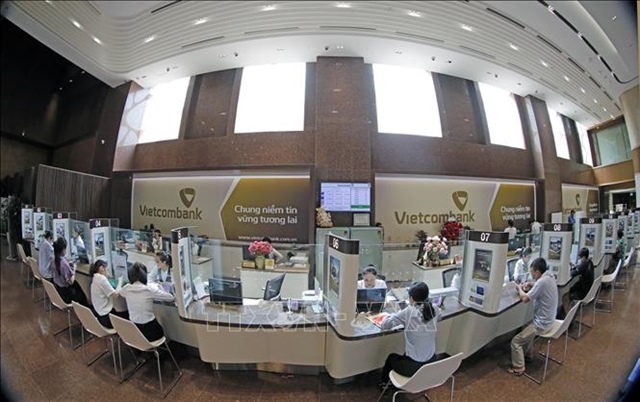State Bank faces interest rate dilemma
State Bank faces interest rate dilemma
The State Bank of Viet Nam plans to maintain the current deposit interest-rate cap to ensure stability on the market. However, many domestic enterprises want the central bank to set a cap on the lending interest rate so they can access more bank loans.

In late December, the central bank cut the deposit interest rate from 14 per cent to 8 per cent per year, and the rate then dropped to 7.5 per cent per year in March.
However, the lending interest rate was not slashed as much as the deposit interest rate.
At many banks, the interest rates on loans for small- and medium-d enterprises are 14-15 per cent per year, while the rates of personal loans are 16-16.5 per cent per year.
Early this month, the central bank lowered the maximum interest rates on short-term Vietnamese dong loans from 12 per cent to 11 per cent per year for five sectors: agriculture, exports, support industries, small- and medium-d enterprises and hi-tech businesses.
However, few enterprises can qualify for loans with the interest rate of 10-11 per cent per year because of strict bank requirements.
As a result, many businesses continue to borrow at a high interest rate, even more than 15 per cent per year.
Lending interest rates are twice as high than the deposit interest rate. In fact, the gap between deposit and lending interest rates is 5-6 per cent per year, while the global-rate difference between the two is a maximum 3 per cent.
In other words, the central bank's floating and constraining the deposit interest rate has brought benefits to only some banks.
Although the central bank has made further cuts in the deposit interest rate, banks' capital costs remain high as the average deposit interest rate still stands at 10-12 per cent per year.
In addition, the banks' credit growth rate has dropped, preventing them from cutting interest rates.
This has caused losses to both depositors and borrowers. In addition, the high interest rates on loans could lead to more companies going bankrupt.
Many companies do not want to borrow cash from banks, which suggests that the interest rate on loans should be under 10 per cent per year.
Inflation has been falling, so the deposit interest rate should be lowered to 6-7 per cent per year, and the lending interest rate to less than 10 per cent per year.
However, the central bank continues to be moderate in its decisions on interest-rate caps.
Setting an interest-rate cap on loans, however, is necessary since it would help the deposit interest-rate fall.
However, the prime interest rate needs to be established in line with current legal regulations that stipulate that the lending interest rate must not exceed 150 per cent of the prime interest rate.
Some banks, however, do not want a lending interest-rate cap. They feel that clients with good payment histories should enjoy a preferential lending interest rate and that a cap could lead to problems with high-risk customers.
The central bank's view is not to set a cap on the lending interest rate for all economic sectors because it would likely cause sources to be pumped into non-priority sectors.
Income tax cut
A draft law on corporate income tax rates prepared by the Ministry of Finance has received support from the public and the business community, as it would help companies with little capital survive and develop.
Under the draft law, the rates would be cut from the current 25 per cent to 23 per cent.
Corporate income tax rates have been adjusted several times over the past nine years. The 2003 law cut rates from 32 per cent to 28 per cent, and the 2008 law lowered them from 28 per cent to 25 per cent.
Beginning in 2014, the Finance Ministry plans to lower the rate to 23 per cent and even further to 20 per cent by 2020.
The Viet Nam Tax Consultancy Association (VTCA), however, alleges that it would be more reasonable for the corporate income tax rate to be reduced to 22 per cent.
The VTCA, despite agreeing with the planned 20 per cent tax rate by 2020, believes that corporate income taxes should be lowered immediately. This would encourage businesses to expand investments and production activity.
Under the draft law, small- and medium-d enterprises, which are fairly strictly defined, would enjoy a lower tax rate of 20 per cent.
The new tax rates would take effect on January 1, 2014. However, local businesses argue that they should begin as early as July 1 this year, arguing that many struggling companies need a helping hand from the Government to survive.
Indeed, when the corporate income tax rate falls to 20 per cent, it would eventually create favourable conditions for more money to enter the state budget.
It would also have the effect of encouraging both foreign and domestic enterprises to invest more in production and trading, and would help to attract foreign direct investment.
In addition, the corporate income tax cut would help companies give a more honest account of their incomes. They would be more willing to pay their taxes, and, as a result, the number of cases of tax evasion and fraud among enterprises would surely decrease.
The draft law would also help ensure justice and equality in line with the Government's tax reform policy and international rules, as well as in business competition.
However, in order to reduce its influence on the State budget, the time period for enforcement should be considered carefully, particularly in the initial period. After the 23 per cent tax rate becomes effective in early 2014, the state budget revenue is expected to drop by VND30.16 trillion (US$1.44 billion) next year.
Unsated public appetite
Over the last week, both global and domestic gold prices fluctuated wildly, but banks and individuals still were eager to get their hands on the precious metal.
On April 17, the State Bank of Viet Nam held its eighth auction to sell 40,000 taels, of which 39,700 taels were sold.
A total of 16 bidders won the right to purchase gold from the central bank. The highest winning price was VND40.8 million a tael and the lowest was VND40.71 million.
A combined 223,600 taels, or nearly 8.34 tonnes, found buyers through the eight auctions organised by the central bank.
For instance, the DOJI Gold and Gems Company bought about 5,000 taels and the Tien Phong Joint-Stock Commercial Bank 2,000 taels.
Meanwhile, the Phu Quy Gold, Silver and Gemstone Company and the Asia Joint-Stock Commercial Bank bought 1,000 taels each.
The healthy appetite for gold occurred because of new regulations issued by the State bank. Under these new rules, enterprises and local banks will have to stop gold deposit and lending activities by June, so lenders need about 20 tonnes of gold to settle all arrears.
After the state bank's eight gold auctions, the gap between global and domestic gold prices widened to a record level of over VND 6.4 million a tael. In addition to banks and gold-trading enterprises, many people still flocked to snap up gold.
In HCM City, the Phu Nhuan Jewelry Company on April 16 sold 1,200 gold taels, four times higher than normal days, while it bought around 300 taels. The company received mostly retail customers who bought 30 gold taels or less.
On April 17, the Sai Gon Jewelry Holding Company also saw a sharp rise in local gold demand, with the firm's trading volume tripling, compared to other days, to about 3,000 taels.
In Ha Noi on the same days, gold transactions on Tran Nhan Tong Street continued to be busy even at 5:00pm. Customers rushed to buy gold, causing a shortage at many stores.
The gold rush indicates that the Vietnamese public has not changed its attitude about buying the metal to ensure financial security. The public's confidence in the dong remains low, so they continue to put their savings in gold.
This gold-buying trend, however, is not reflected in other parts of the world.
While the Vietnamese desire to buy gold remains unabated, many Japanese have been waiting in long queues to sell the precious metal.
In addition, many funds and investors around the world have been giving up gold, citing that the precious metal's "golden age" was likely to end.
In fact, within a week, the global gold price fell by 17 per cent.
vietnamnews




























